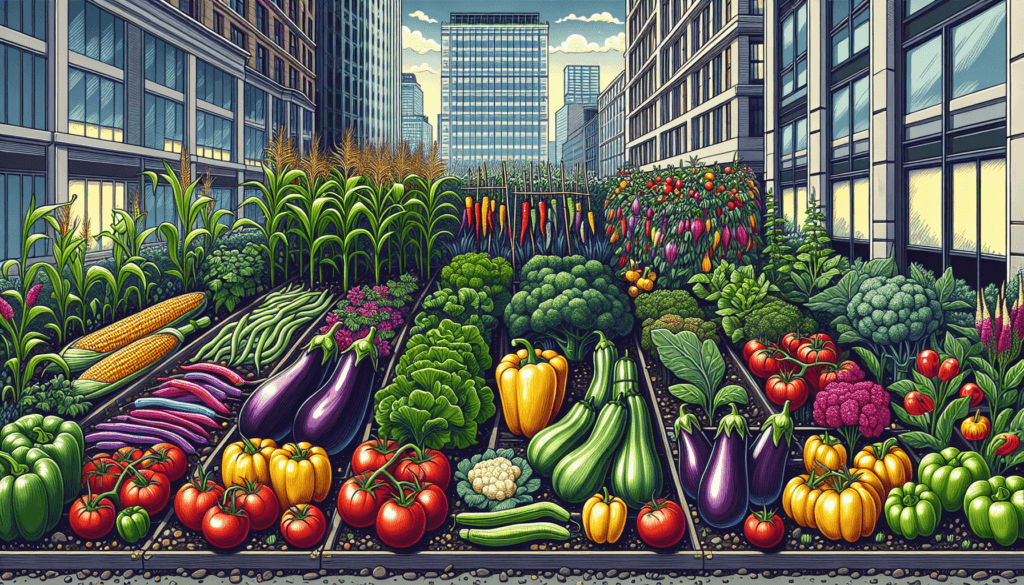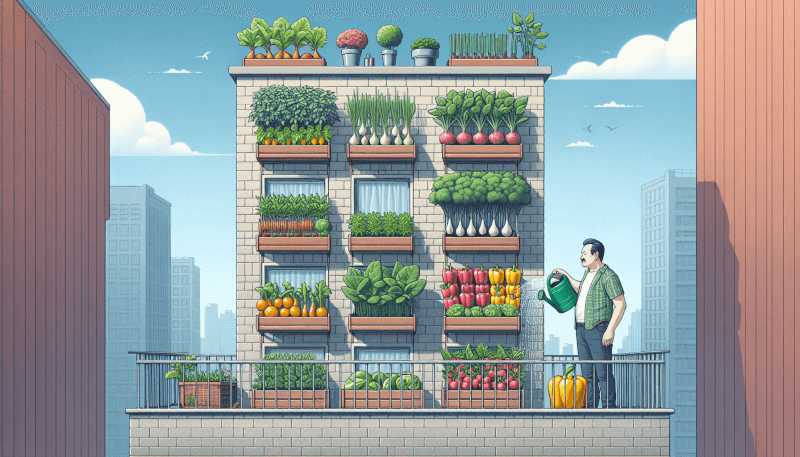Are you passionate about urban gardening and looking for the best vegetables to grow in your own backyard? Look no further! In this article, we will introduce you to the top 9 vegetables that are perfect for your urban garden. From leafy greens like spinach and kale to versatile and nutrient-rich tomatoes and peppers, these vegetables will not only thrive in a small space but also provide you with a bountiful harvest. Get ready to roll up your sleeves and dig into the wonderful world of urban vegetable gardening!
1. Tomatoes
Varieties of tomatoes to grow in an urban garden
When it comes to growing tomatoes in an urban garden, you have a variety of options to choose from. Some popular tomato varieties that thrive in small spaces include cherry tomatoes such as Sweet 100, Sun Gold, and Tumbling Tom. These varieties produce an abundance of bite-sized fruits and are perfect for snacking or adding to salads. Another great option is the Patio Princess, a compact determinate variety that is ideal for container gardening. If you prefer larger tomatoes, consider growing varieties like Celebrity, Early Girl, or Big Boy, which can also be grown in containers successfully.
Tips for growing tomatoes in containers
Growing tomatoes in containers can be a rewarding experience, but it requires some special care to ensure optimal growth and productivity. Start by selecting a container that is at least 15 inches in diameter and has drainage holes at the bottom. Use a well-draining potting mix specifically formulated for containers. Tomato plants need a lot of sunlight, so place your containers in a spot that receives at least 6-8 hours of direct sunlight each day. Water the plants regularly, making sure the soil stays consistently moist but not waterlogged. Consider using organic fertilizers specifically formulated for tomatoes to provide the necessary nutrients. Finally, prune the tomato plants to remove suckers and promote better air circulation, which can help prevent disease.
Common pests and diseases to watch out for in tomato plants
While growing tomatoes in an urban garden can be a satisfying endeavor, it’s important to be aware of the common pests and diseases that can affect tomato plants. One of the most common pests is the tomato hornworm, a large green caterpillar that can quickly defoliate plants. Keep an eye out for their telltale droppings and remove them by hand if you spot them. Aphids, whiteflies, and flea beetles are other common pests that can attack tomato plants. Regularly inspect your plants and use organic insecticides if necessary. Diseases like early blight, late blight, and blossom end rot are also common in tomatoes. To prevent these diseases, avoid overcrowding your plants and ensure good air circulation. Mulching can also help prevent soil-borne diseases.
2. Lettuce
Different types of lettuce suitable for urban gardening
Lettuce is a great vegetable to grow in an urban garden due to its compact size and quick growing cycle. There are several types of lettuce that thrive in small spaces, including loose-leaf lettuce, butterhead lettuce, and romaine lettuce. Loose-leaf lettuce varieties like Salad Bowl, Mesclun Mix, and Red Sails are perfect for continuous harvesting as you can pick the outer leaves while allowing the inner leaves to continue growing. Butterhead lettuce varieties such as Bibb or Buttercrunch have tender leaves that form compact heads. Romaine lettuce varieties like Parris Island or Little Gem are known for their crispy texture and upright growth.
How to grow lettuce in small spaces
Growing lettuce in small spaces is a breeze, as it doesn’t require much room to grow. Start by selecting a container that has drainage holes and is at least 4-6 inches deep. Fill the container with a well-draining potting mix and moisten it thoroughly. Sow the lettuce seeds on the surface of the soil, leaving about half an inch of space between each seed. Lightly cover the seeds with a thin layer of soil and mist them with water. Place the container in a partially shaded area, as lettuce prefers cooler temperatures. Water the plants regularly to keep the soil evenly moist but avoid overwatering. Within a few weeks, you’ll be able to start harvesting the outer leaves while allowing the inner leaves to continue growing.
Harvesting and storing lettuce
Lettuce is best enjoyed when it is freshly harvested. When picking lettuce leaves, choose the outer leaves first, as this will allow the inner leaves to continue growing. Use a sharp pair of garden scissors or shears to cut the leaves just above the soil level. Rinse the leaves thoroughly to remove any dirt or debris before consuming them. If you have more lettuce than you can use at once, you can store it in the refrigerator to keep it fresh for a longer period. Simply wrap the leaves in a paper towel and place them in a plastic bag or airtight container. Lettuce can usually be stored for up to a week in the refrigerator before it starts to wilt.

3. Peppers
Popular pepper varieties for urban gardens
Peppers are a versatile vegetable that can add a burst of flavor to any dish, and they can be successfully grown in urban gardens. Some popular pepper varieties that thrive in small spaces include bell peppers, jalapenos, and mini sweet peppers. Bell pepper varieties like California Wonder and Miniature Chocolate Bell are known for their crisp texture and sweet flavor. Jalapenos are famous for their spicy kick and are great for adding some heat to your meals. Mini sweet pepper varieties like Sweetie Pie and Lunchbox Red are perfect for snacking or adding a pop of color to salads and stir-fries.
Caring for pepper plants in containers
Growing pepper plants in containers requires some attention to detail, but with the right care, they can thrive and produce an abundant harvest. Start by choosing a container that is at least 12-14 inches in diameter and has drainage holes. Fill the container with a well-draining potting mix mixed with compost to provide the necessary nutrients. Pepper plants need plenty of sunlight, so place the containers in a spot that receives at least 6-8 hours of direct sunlight per day. Water the plants regularly, keeping the soil consistently moist but not waterlogged. Peppers are heavy feeders, so consider using a balanced organic fertilizer every few weeks to ensure they get the nutrients they need. Stake the plants or use tomato cages for support as they grow.
Harvesting and using peppers
Peppers can be harvested at various stages of maturity, depending on your preference. When the peppers have reached their desired size and color, simply cut them off the plant using a sharp pair of scissors or pruning shears. Be careful not to damage the plant or any nearby fruits. It’s important to note that the longer peppers stay on the plant, the hotter they become. If you prefer milder peppers, harvest them when they are still green. To use peppers in your cooking, simply incorporate them into your favorite recipes. Peppers can be eaten raw in salads, stuffed with a variety of fillings, roasted, grilled, or used in salsas, sauces, and stir-fries. The possibilities are endless!
4. Spinach
Benefits of growing spinach in an urban garden
Spinach is a nutrient-packed leafy green vegetable that is worth growing in your urban garden. It is rich in vitamins A, C, and K, as well as iron, calcium, and folate. By growing spinach at home, you can have access to fresh, pesticide-free leaves whenever you need them. Incorporating spinach into your diet can support overall health and provide numerous benefits, such as boosting immunity, improving eye health, and promoting healthy digestion. Additionally, spinach is a versatile ingredient that can be used in salads, smoothies, soups, and sautés, making it a valuable addition to any urban garden.
Choosing the right type of spinach for limited space
When it comes to growing spinach in a limited space, compact varieties that are suitable for container gardening are ideal. Look for spinach varieties like Baby’s Leaf Hybrid, Space, or Melody, as these are known for their compact growth habit and can thrive in small containers. These varieties typically have tender leaves that are perfect for salads and are quick to mature, allowing you to enjoy fresh spinach in just a few weeks. Depending on your preferences, you can also choose between savoyed spinach, which has crinkled leaves, or smooth-leaf spinach, which has flat leaves.
Tips for maintaining healthy spinach plants
To ensure the health and productivity of your spinach plants, there are a few key tips to keep in mind. First, spinach prefers cooler temperatures, so it’s best to plant it during the cooler seasons, such as spring or fall, to avoid bolting. Select a container that is at least 6 inches deep and has good drainage. Fill the container with a well-draining potting mix and sow the spinach seeds about half an inch deep, leaving about an inch of space between each seed. Keep the soil consistently moist but not waterlogged, and provide the plants with at least 4-6 hours of sunlight per day. Regularly harvest the outer leaves when they are about 3-4 inches long to promote continuous growth.

5. Cucumbers
Space-saving cucumber varieties for urban gardens
Cucumbers are a refreshing and versatile vegetable that can thrive in urban gardens with limited space. When it comes to growing cucumbers in small spaces, compact or bush varieties are the way to go. Some space-saving cucumber varieties that are well-suited for container gardening include Bush Slicer, Salad Bush, and Patio Snacker. These varieties are known for their compact growth habit, making them perfect for small gardens or balconies. Despite their smaller size, they still produce an abundant harvest of delicious cucumbers.
Container gardening techniques for cucumbers
Growing cucumbers in containers requires a few key techniques to ensure success. Start by selecting a container that is at least 12 inches in diameter and has good drainage. Cucumbers have deep roots, so choose a container that is at least 12 inches deep to accommodate their root system. Fill the container with a well-draining potting mix mixed with compost to provide the necessary nutrients. Cucumbers need full sun, so place the containers in a sunny spot that receives at least 6-8 hours of direct sunlight per day. Water the plants regularly, keeping the soil consistently moist but not waterlogged. Consider using a trellis or a cage for support as the vines grow, as this will help save space and encourage better air circulation.
Dealing with common cucumber plant problems
While cucumbers are relatively easy to grow, they can be susceptible to certain pests and diseases. One common problem is powdery mildew, a fungal disease that appears as a powdery white coating on the leaves. To prevent powdery mildew, ensure good air circulation around the plants and avoid overhead watering. Spider mites can also be an issue, especially in hot and dry climates. Regularly inspect the undersides of the leaves for tiny pests and use organic insecticides if necessary. Cucumber beetles and aphids are other common pests that can attack cucumber plants. Use insecticidal soaps or organic insecticides to control these pests. Additionally, regular watering and proper fertilization can help prevent issues like blossom end rot, a common physiological disorder in cucumbers.
6. Radishes
Fast-growing radish varieties perfect for urban gardening
If you’re looking for a quick-growing vegetable to add to your urban garden, radishes are an excellent choice. Radishes are known for their fast growth, allowing you to enjoy fresh radishes in as little as 3-4 weeks after planting. Some fast-growing radish varieties that are perfect for urban gardening include Cherry Belle, French Breakfast, and Easter Egg. These varieties produce crispy and flavorful radishes that can be harvested at various sizes, depending on your preference.
Growing radishes in small containers or raised beds
Growing radishes in small containers or raised beds is a straightforward process. Start by selecting a container or raised bed that is at least 6 inches deep and fill it with well-draining soil. Radishes prefer loose soil, so consider adding compost or vermiculite to improve the soil structure. Sow the radish seeds about half an inch deep and cover them lightly with soil. Keep the soil consistently moist, but avoid overwatering as it can cause the radishes to become pithy. Radishes prefer cooler temperatures, so try to plant them during the spring or fall seasons. Within a few weeks, you’ll be able to harvest your radishes when they reach their desired size.
Harvesting and enjoying radishes
Radishes are typically ready for harvest within 3-4 weeks after planting, making them a satisfying choice for urban gardeners. To harvest radishes, simply pull them out of the soil or use a garden fork to loosen the soil around them. Radishes should be harvested when they are still small and firm, as they can become tough and pithy if left in the ground for too long. Once harvested, rinse the radishes to remove any dirt or debris. Radishes can be enjoyed raw in salads, sliced and added to sandwiches, or pickled for a tangy snack. The peppery flavor of radishes adds a refreshing kick to various dishes, making them a versatile and tasty addition to any meal.

7. Beans
Different types of beans suitable for urban environments
Beans are a nutritious and easy-to-grow vegetable that can thrive in urban environments. There are several types of beans that are well-suited for small-space gardening, including bush beans, pole beans, and dwarf varieties. Bush beans like Contender or Blue Lake are compact and don’t require support, making them ideal for small gardens or containers. Pole beans, on the other hand, are vining plants that can be trained to grow vertically, taking advantage of limited space. Some popular pole bean varieties for urban gardening include Kentucky Wonder and Scarlet Runner. Dwarf varieties, such as Provider or Rocdor, have petite plants that produce an abundant harvest of beans and are perfect for container gardening.
Vertical gardening methods for growing beans
Vertical gardening is an excellent technique for growing beans in urban environments, as it maximizes limited space and promotes better air circulation. To grow beans vertically, you’ll need a support structure such as a trellis, bamboo stakes, or a bean tower. Install the support system in your garden or containers before planting the beans. Plant the bean seeds at the base of the support structure, following the recommended spacing for the specific variety you’re growing. As the bean plants grow, gently train the vines to climb up the support. Be cautious not to damage the delicate plants. Regularly check the vines and gently tie them to the support if needed. Growing beans vertically not only saves space but also makes harvesting easier and reduces the risk of disease.
Bean plant care and maintenance
Taking care of bean plants is relatively easy, especially if you provide them with the right conditions. Beans thrive in full sun, so make sure to place them in a spot that receives at least 6-8 hours of direct sunlight per day. Water the plants regularly, ensuring the soil stays consistently moist but not waterlogged. Avoid overhead watering, as it can promote the development of foliar diseases. Mulching around the base of the plants can help conserve moisture and suppress weeds. Beans are nitrogen-fixing plants, meaning they can take atmospheric nitrogen and convert it into a form that is usable by plants. However, it’s still beneficial to provide a balanced organic fertilizer to support optimal growth and production. Insect pests, such as bean beetles or aphids, can occasionally be an issue. Inspect the plants regularly and use organic insecticides if necessary to control pest populations.
8. Carrots
Best carrot varieties for container gardening in the city
Carrots are a nutritious root vegetable that can be grown successfully in containers in the city. When selecting carrot varieties for container gardening, look for those that have a shorter and stumpier growth habit, as these are better suited for limited space. Some recommended carrot varieties for container gardening include Thumbelina, Short ‘n Sweet, and Paris Market. These compact varieties produce small to medium-sized carrots that do well in containers, making them an excellent choice for urban gardeners.
Creating the right soil conditions for growing carrots
Carrots thrive in loose, well-draining soil that is free from rocks and clumps. Before planting carrots in containers, ensure the soil is loose and friable by mixing in compost or vermiculite. Carrots also prefer slightly sandy soil, as it allows for easy root penetration and prevents the development of misshapen carrots. Fill the container with the prepared soil, leaving about an inch of space at the top. Sow the carrot seeds directly into the container, spacing them according to the variety’s recommendations. Carrot seeds are tiny, so mix them with some sand or fine soil to ensure even spacing. Lightly cover the seeds with a thin layer of soil and mist them with water. Keep the soil consistently moist until the seeds germinate, which usually takes 1-3 weeks.
Common issues and solutions for carrot plants
Carrots are generally low-maintenance plants, but they can encounter a few common issues that urban gardeners should be aware of. One common problem is carrot root fly, a pest that lays its eggs near the base of the carrot plants. To prevent carrot root fly, cover the plants with a floating row cover or insect netting to create a physical barrier. Thin the carrot seedlings when they are about 2 inches tall to provide enough space for the roots to develop properly. Carrots are also prone to developing forked or misshapen roots if grown in rocky or compacted soil. Ensure the soil is loose and well-draining to prevent this issue. Regularly water the plants to keep the soil consistently moist, as dry conditions can lead to tough or woody carrots. Harvest the carrots when they reach the desired size, gently pulling them out of the soil to avoid damage.

9. Herbs
Popular herbs that thrive in urban gardens
Herbs are a fantastic addition to any urban garden, as they not only add flavor to your dishes but also provide various health benefits. Some popular herbs that thrive in urban gardens include basil, parsley, mint, rosemary, and thyme. Basil is an aromatic herb that adds a fresh and summery flavor to dishes. Parsley is a versatile herb that can be used in salads, soups, or as a garnish. Mint is known for its refreshing taste and is perfect for making tea or adding to cocktails. Rosemary has a distinct pine-like aroma and is great for roasting meats or flavoring roasted vegetables. Thyme adds a savory and earthy flavor to a variety of dishes and can be used both fresh and dried.
Growing herbs in small pots or windowsills
Growing herbs in small pots or on windowsills is a convenient way to have fresh herbs at your fingertips. Start by selecting small pots with drainage holes that fit the size of the herb plants you want to grow. Fill the pots with a well-draining potting mix and plant the herbs, ensuring they have sufficient space to grow. Place the pots in a sunny windowsill or a spot that receives at least 4-6 hours of direct sunlight per day. Water the herbs regularly, keeping the soil moist but not waterlogged. Herbs generally do well with less water compared to other vegetables, so be careful not to overwater. Regularly prune the herbs by pinching off the top leaves to encourage bushier growth and prevent them from becoming leggy.
Harvesting and preserving herbs
Herbs are best enjoyed when they are freshly harvested, as this allows you to fully experience their vibrant flavors. When harvesting herbs, choose the healthy leaves and stems and avoid taking more than one-third of the plant’s total foliage at a time. Use sharp scissors or shears to prune the herbs, cutting just above a set of leaves or a node. Rinse the herbs under cool water to remove any dirt or debris and pat them dry. Fresh herbs can be used immediately in your favorite recipes, adding a burst of flavor. If you have more herbs than you can use, you can preserve them for later use. Air drying is a simple method for preserving herbs. Bundle the stems together and hang them upside down in a dry, well-ventilated area until the leaves are completely dry. Once dried, store the herbs in airtight containers away from sunlight and moisture. Alternatively, you can chop the herbs and freeze them in ice cube trays with water or oil for easy portioning and use in cooking.


